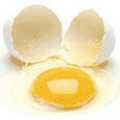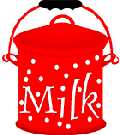作者 唐妮拉米朵斯
幾年前,當我去新建好的雞舍撿起第一顆剛下的溫熱的蛋時,我敬畏地盯著這顆蛋,心理想:「母雞到底是如何辦到這件事呢?」牠每天只吃些穀類、小蟲和廚餘,居然就能變出一顆裡面是蛋黃、外面是殼的東西,一切是如此地完美和協調。甚至有時蛋還能夠變成一隻雞,真是太令人感到驚奇了!
雖然蛋每天都成打地在我們的農場出現,但我仍然認為每一顆蛋,都是一個奇蹟。最頂尖的化學家到目前為止,都無法將碾碎的穀物、包心菜葉變成一顆蛋,更何況是一隻雞。同樣地,生化技術也不能化青草為羊毛,甚至長成一隻活生生的綿羊;也許我的羊不是那麼的聰明,然而牠們就是有如此神力能夠辦得到。

這些年來,因為我從來沒養過母牛,所以有一種農場奇蹟我始終沒能親眼目睹-牧草轉化成牛隻和牛奶的過程。我很怕牛那龐大的體積和一天兩次的擠奶工作。當時我丈夫常常說:「被關在監獄和養一頭牛,兩者唯一的不同就是,在監獄中你不需要擠奶。」
所以我對雞和羊如此著迷。直到兩年前,一個畜牧業的同行,開著輛後座載著一頭小澤西牛的卡車來找我,我們替這頭牛命名為梅波(Maple)。梅波那時才剛生下一頭小牛,所以當時我們有喝不完的牛奶。
我不應該會對那麼新鮮、香甜的有機牛奶感到那麼驚訝的;畢竟,我之前也是一旦嚐過新鮮的有機雞蛋後,就再也不去外頭的超市買雞蛋吃。同樣的道理,吃過自己種的蔬菜水果後,我也不會想再去買超市的蔬果。但是當時不知怎麼地,我只想著,牛奶不過是牛奶而已。因此,我再一次學習到,我們在大量工業化製造的食物來源當中,失去了以往能夠在生活中品嚐原味、與產生質疑的那種權利。
對於我家牛的產量,我同樣感到驚訝。澤西牛其實不是乳產量多的牛種。但是牠每天可以持續地達到顛峰的產量,擠出五加侖的牛乳。這對於像飼養好斯坦種乳牛(Holsteins)、以及使用真空的管線和儲存槽的大農場來說,是不算什麼,但是當你是在家中的廚房操作時,一天五加侖的牛奶,就像是一條充滿著各種可能性的河流。你可以用牛奶做很多偉大的事情!

我們的牛奶大部分都做成芝士。直到一個月前,我對牛奶是如何變成芝士只有很模糊的理解,雖然這個古老的技術曾經存在過幾乎每一個鄉村家中。做法是:將牛奶在一個不鏽鋼容器中慢慢的加熱,同時把神奇的乳酸菌攪拌進去, 牛奶中的乳糖就會轉變成乳酸。你要注意牛奶的酸度來加入乳酸菌。然後在正確的時間加入凝乳酵素來凝結酸化的牛乳。 然後,依據你要做的芝士種類來切塊,加熱,攪拌,以及加鹽到凝乳中,然後再將它們舀到放置著芝士過濾網的容器中,用磚塊或盛水的桶子來壓。第二天早上,你就會有一塊芝士了。然後將它放入鹽水中,最好是放在一個可以保持常溫以及保持溼度的洞穴中儲存。由於我們家沒有這樣的洞穴,就建了一個可以走進去的冷藏室。
我們剛剛嚐過我們製作的第一塊芝士,它被放了45天。因為才放了不到最少需要時間的一半,所以味道平淡。但它是塊好芝士,嚐起來有堅果味、有彈性、入口即化。純粹就我個人觀點而言,它已經在邁向榮耀的半路上。就像面對那第一顆雞蛋一樣,我感到無限敬畏。
我不是一個能拖延喜悅的人,所以我用了一些牛奶來實驗,做一些馬上可以吃的東西。至今我最喜歡的做法是, 先將兩加侖牛奶上面極好的鮮奶油舀起來,然後倒入一個有曲柄把手的攪奶器中。過了20分鐘沒精打采的攪拌後(我是邊攪邊看書的),就有了半磅黃金般的奶油了。然後我倒入三杯的牛奶,孩子們叫這是奶油牛奶(buttermilk)。用來製作餅乾或鬆餅都很好。
拿掉上層的鮮奶油後就留下一加侖半的脫脂牛奶。然後我把它加熱到90度,再倒入市面上買的奶油牛奶(含有活性乳酸菌)。在放置一整夜後,它分成了一層果膠般的凝乳、以及一層黃色水狀的乳漿。(「在製作過程中有一隻蜘蛛坐在她旁邊」…現在我總算知道,小時候的兒歌裡,這歌詞是怎麼來的。)我將上層的凝乳切成幾小塊,加熱一會兒,再把它們拿出來,然後撒入一些的鹽。這就是啦!一夸脫又一半的低脂鄉村芝士。雖然實際上是乳酸菌、乳牛以及擠牛奶的人在做這件事,我仍然感到自己非常聰明。
只要再一次的過程就能將乳漿變成麗可塔(ricotta )芝士。可是我們用做別的芝士剩下的乳漿來做麗可塔芝士,而結果我們的冰箱就塞滿了各種成品(千層麵,薄餅,芝士蛋糕)。我將乳漿拿到外面給雞吃,看著它們很高興地吃著。而所有的營養會到雞蛋裡。而雞和牛的糞便做成的肥料又可以拿到院子來種蔬菜。
這些都是簡單的奇蹟。就有如烘培麵包和自製書架一樣,是種令人滿意的成就。新鮮美味的食物,而養分的循環就在手邊。且對大地和人類都健康有益。有時,我懷疑所有我們認為理所當然的進步,我們到底是為了什麼匆促的前進呢?而我們又失去了什麼?
by Donella Meadow
30 Jan 2001
Years ago, when I went out to my new chicken house and found the very first freshly laid egg, I stared at it in awe. "How did that hen do that?" I wondered. She takes in grain and bugs and kitchen scraps and turns them into an egg Shell on the outside, white and yolk on the inside, all proper and perfect. Under the right conditions (or hen) that egg could even become a chick. Just amazing!
I still think every egg is a miracle, though they appear on our farm by the dozen every day. Our leading-edge chemists are miles from being able to convert cracked corn and cabbage leaves into an egg, much less a chick. The biotech biz can't make grass into wool and lambs either, though my sheep, which were not at all smart, used to do it with great reliability.
All these years the one farm miracle I never got to witness firsthand was the transformation of hay into calves and milk. I never got a cow. I was daunted by their size and by the prospect of never-fail, twice-daily milkings. "The only difference between being in jail and having a cow," my then-husband used to recite, "is that in jail you don't have to milk the cow."
So I stuck with chickens and sheep, until two years ago, when one of my farm-mates drove in one day with a tiny Jersey calf in the back of the truck. We named her Maple. Maple has just had her own first calf, and we are awash in milk.
I shouldn't have been surprised at how good fresh, sweet, organic milk is. After all, once I tasted fresh organic eggs I never went back to supermarket ones. The same goes for vegetables and fruits out of the garden. But somehow I thought milk was milk was milk. So I have just learned one more time what we give up in taste and quality for the dubious privilege of living far away from the sources of our increasingly industrialized food.
I was also surprised at the quantity. Jerseys are not big producers, and ours is still working up to her peak, but she's already milking five gallons a day. That's nothing to a big farm with Holsteins and vacuum lines and bulk tanks. But when you're operating out of your kitchen, five gallons a day is a river -- a river of possibilities. You can do so many great things with milk!
Most of ours goes into cheese. Up to a month ago I had only the vaguest idea how milk becomes cheese, though this age-old art was once practiced in most rural households. Here's how it works. You heat milk gently in a stainless steel vat and stir in a magical lactobacillus that turns the milk sugar lactose into lactic acid. You monitor the acidity of the mix to follow the bugs' working. At just the right moment you add rennet, which congeals the curds. Then, depending on what kind of cheese you're making, you cut, heat, stir, and salt the curds, scoop them into cheesecloth-lined forms, and press them (with bricks or a bucket of water). The next morning you have a wheel of cheese. You soak it in brine, then age it, ideally in a cave with constant temperature and humidity. Lacking a cave, we built a walk-in cooler.
We just tasted our first cheese, now 45 days old. It's bland, because it's only halfway through its minimal aging period. But it's nutty, elastic, melty, good cheese. In my totally biased opinion, it's on its way to glory. As with that first egg, I'm in awe.
I am not good at delayed gratification, so I take some milk to experiment with products that can be eaten immediately. So far my favorite trick is this: I start with two gallons of milk and scoop off the top layer of wonderful, thick cream. The cream goes into a hand-cranked churn. After 20 minutes of lackadaisical cranking (I read a book while I do it), the paddles hang up on a half pound of golden butter. I pour off three cups of surrounding liquid, which, kids, is called buttermilk. Great for biscuits or pancakes.
Taking off the cream leaves a gallon and a half of skim milk. That I warm to 90 degrees and stir in a little commercial buttermilk (which contains live lactobacillus). After sitting overnight, it separates into white jelly-like curds and watery yellow whey. (Along came a spider and sat down beside her ... now I know where those nursery rhymes come from.) I cut the curds into pieces, warm them a little, scoop them out, add a bit of salt, and voila! A quart and a half of low-fat cottage cheese! I feel very clever, though it was the bacillus and the cow and the housemate who milked the cow who did the real work.
One more transformation could turn the whey into ricotta. But we make that with the whey from the other cheesemaking, so our refrigerator is well stocked. (Lasagna, blintzes, cheesecake!) I take the whey out to the chickens, who slurp it up contentedly. It's full of nutrients that flow into the eggs. The composted chicken and cow manure go to the garden to flow into the vegetables.
Simple miracles. Satisfying work, like baking bread or building a shelf. Fresh, delicious food. Nutrient cycles closed right at hand. Health for land and people. Sometimes I wonder, with all our supposed progress, what we're rushing toward and what we're leaving behind.
唐妮拉米朵斯是達特茅斯學院(Dartmouth College)環境研究的副教授,也是佛蒙特州(Vermont,Vt。)哈特蘭(Hartland)永續協會(Sustainability Institute)的理事長。
全文及圖片詳見http://www.gristmagazine.com/grist/citizen/citizen013001.stm




